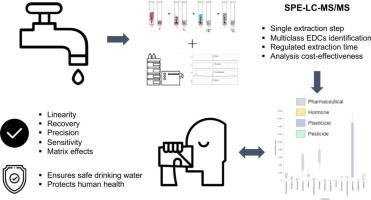Journal of Hazardous Materials ( IF 12.2 ) Pub Date : 2021-09-24 , DOI: 10.1016/j.jhazmat.2021.127327 Sze Yee Wee 1 , Nur Afifah Hanun Ismail 1 , Didi Erwandi Mohamad Haron 2 , Fatimah Md Yusoff 3 , Sarva Mangala Praveena 4 , Ahmad Zaharin Aris 5

|
Humans are exposed to endocrine disrupting compounds (EDCs) in tap water via drinking water. Currently, most of the analytical methods used to assess a long list of EDCs in drinking water have been made available only for a single group of EDCs and their metabolites, in contrast with other environmental matrices (e.g., surface water, sediments, and biota) for which more robust methods have been developed that allow detection of multiple groups. This study reveals an analytical method of one-step solid phase extraction, incorporated together with liquid chromatography–tandem mass spectrometry for the quantification of multiclass EDCs (i.e., pharmaceuticals, hormones, plasticizers, and pesticides) in drinking water. Fifteen multiclass EDCs significantly varied in amount between field samples (p < 0.05), with a maximum concentration of 17.63 ng/L observed. Daily exposure via drinking water is unlikely to pose a health risk (risk quotient < 1). This method serves as an analytical protocol for tracing multiclass EDC contamination in tap water as part of a multibarrier approach to ensure safe drinking water for good health and well-being. It represents a simpler one-step alternative tool for drinking water analysis, thereby avoiding the time-consuming and expensive multi-extraction steps that are generally needed for analyzing multiclass EDCs.
中文翻译:

饮用水中的药物、激素、增塑剂和杀虫剂
人类通过饮用水暴露于自来水中的内分泌干扰化合物 (EDC)。目前,与其他环境基质(例如地表水、沉积物和生物群)相比,用于评估饮用水中一长串 EDC 的大多数分析方法仅适用于一组 EDC 及其代谢物为此已经开发了更强大的方法,允许检测多个组。本研究揭示了一种一步固相萃取的分析方法,结合液相色谱-串联质谱法,用于定量饮用水中的多类 EDC(即药物、激素、增塑剂和杀虫剂)。15 个多类 EDC 在现场样本之间的数量显着不同(p < 0.05),观察到的最大浓度为 17.63 ng/L。每天通过饮用水接触不太可能构成健康风险(风险商 < 1)。该方法用作追踪自来水中多类 EDC 污染的分析协议,作为确保安全饮用水以促进健康和福祉的多重屏障方法的一部分。它代表了一种用于饮用水分析的更简单的一步式替代工具,从而避免了分析多类 EDC 通常需要的耗时且昂贵的多提取步骤。










































 京公网安备 11010802027423号
京公网安备 11010802027423号